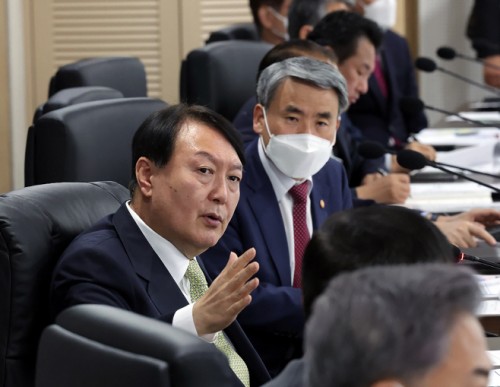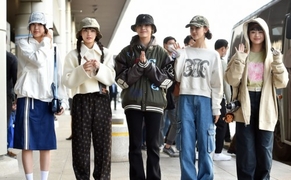 |
| President Yoon Suk-yeol presides over a meeting of the National Security Council at the presidential office in Seoul on May 25, 2022, following North Korea’s missile launching. / Source: Yonhap News |
AsiaToday reporters Lee Seok-jong & Lee Wook-jae
After North Korea launched one intercontinental ballistic missile (ICBM) and two short-range ballistic missiles (SRBM) on Wednesday, South Korean officials warn that Pyongyang may conduct a seventh nuclear test. With the June local elections imminent, attention is focused on whether the North will resume its nuclear test for the first time in four years since 2017.
“Operation tests of a nuclear detonation device, which are to prepare for the seventh nuclear test at Punggye-ri, are being detected,” said Kim Tae-hyo, first deputy director of the National Security Office. Detonators are devices used for igniting the high explosive section of a nuclear weapon. A detonator operation test is one of the signs that preparation for a nuclear test is imminent.
“The possibility of an imminent nuclear test in the next day or two is low, but after that, there is certainly a possibility,” Kim said. “The final preparation stage for a nuclear test of a scale and quality the North Korean authorities want is imminent.”
On the series of the North Korean missile launches, Kim said, “The fact that North Korea launched two SRBMs means that it intends to improve its nuclear delivery capability.”
It is hard to predict when the North will resume its nuclear test, but it is expected that the North may resume before the upcoming local elections, as the missile launch was apparently intended to influence the local elections. “I believe there was a political motivation behind the test-firings, such as to interfere in the imminent domestic political schedule in the Republic of Korea, and to test the new government’s security posture,” Kim said.
Previously, President Yoon Suk-yeol presided over a National Security Council (NSC) meeting at around 7:35 a.m. after being briefed on the launches. President Yoon ordered that the implementation of practical measures for the activation of extended deterrence and strengthening of the South Korea-US combined defense posture, as agreed upon by the leaders of South Korea and the United States.
Immediately after the NSC meeting, the government issued a statement, warning that North Korea’s “continued provocations will only end in even stronger and swifter combined deterrence between South Korea and the Unite States, and bring about North Korea’s international isolation.”
The government took military and diplomatic actions along with the United States. It staged ‘Elephant Walk’ training involving some 30 fully-armed F-15K fighter jets. Besides, South Korea and the U.S. jointly fired surface-to-surface missiles toward the East Sea, in response to the North Korean missile threats on Wednesday. This involved one of South Korea’s Hyunmoo-II missiles, and one U.S. ATACMS or Army Tactical Missile System.
#NSC meeting #North Korea #nuclear test #Yoon Suk-yeol
Copyright by Asiatoday
Most Read
-
1
-
2
-
3
-
4
-
5
-
6
-
7





















